Abstract
From November 1978 to October 1981, a total of 7716 specimens of nasopharyngeal secretions were examined by the rapid immunofluorescence technique to determine the frequency of infections caused by the respiratory syncytial virus (RSV), influenza virus A, and parainfluenza viruses 1 and 3. The tests were carried out in six different virus laboratories located in Newcastle upon Tyne (England), Copenhagen, Oslo, Stockholm, Turku (Finland), and Vienna; laboratories in Lisbon and Paris participated in the study for shorter periods. The specimens were collected from infants and children less than 6 years of age who had been admitted to hospital with an acute respiratory infection. Standardized techniques and quality controlled reagents were used. At least one of the above viruses was detected in 1927 (25%) of the specimens: RSV in 1475, influenza virus A in 123, parainfluenza virus 1 in 110, and parainfluenza virus 3 in 237 specimens. Respiratory syncytial virus dominated in all centres, but in some Scandinavian centres distinct outbreaks due to this virus occurred only once or twice during the 3 years' study period. Three outbreaks of RSV were observed in Newcastle, but here an unprecedented delay of the first winter's epidemic occurred. The delay was associated with prolonged school closures in the area, and with a very early outbreak of influenza. Parainfluenza virus 3, which was predominantly a summer virus in Newcastle, was most frequently encountered during the colder months of the year in the other centres.
Full text
PDF
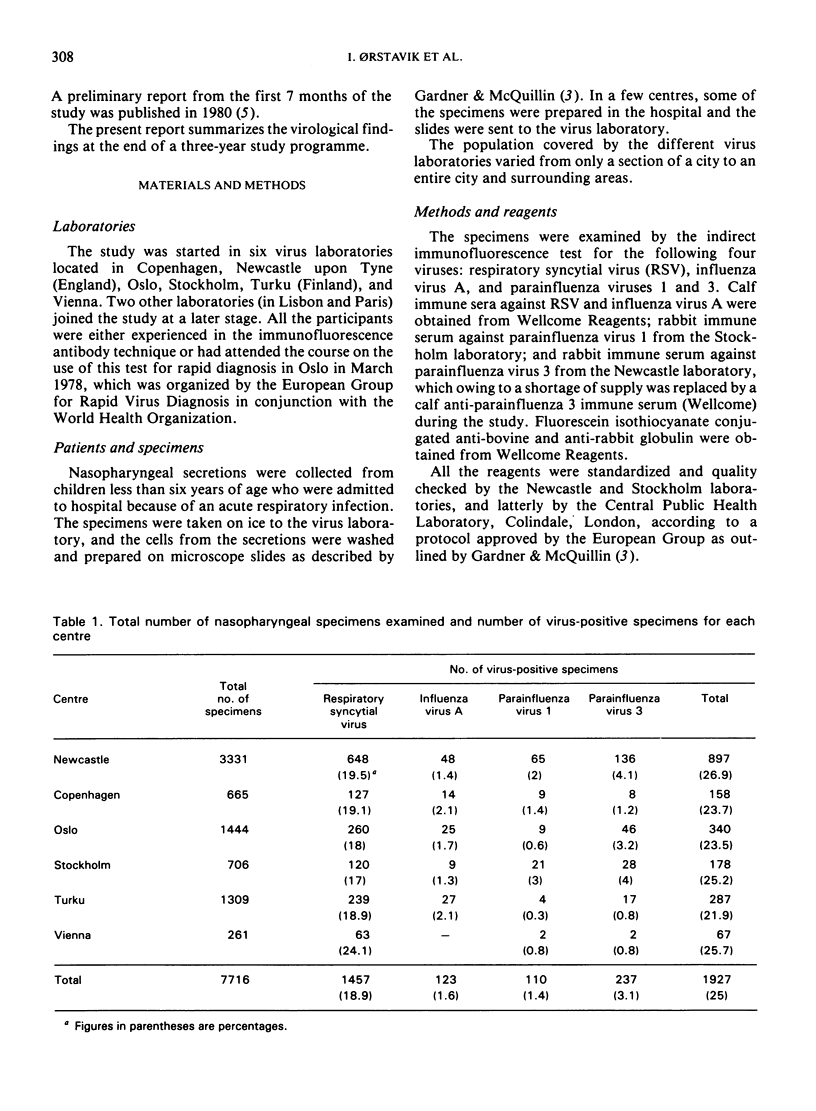
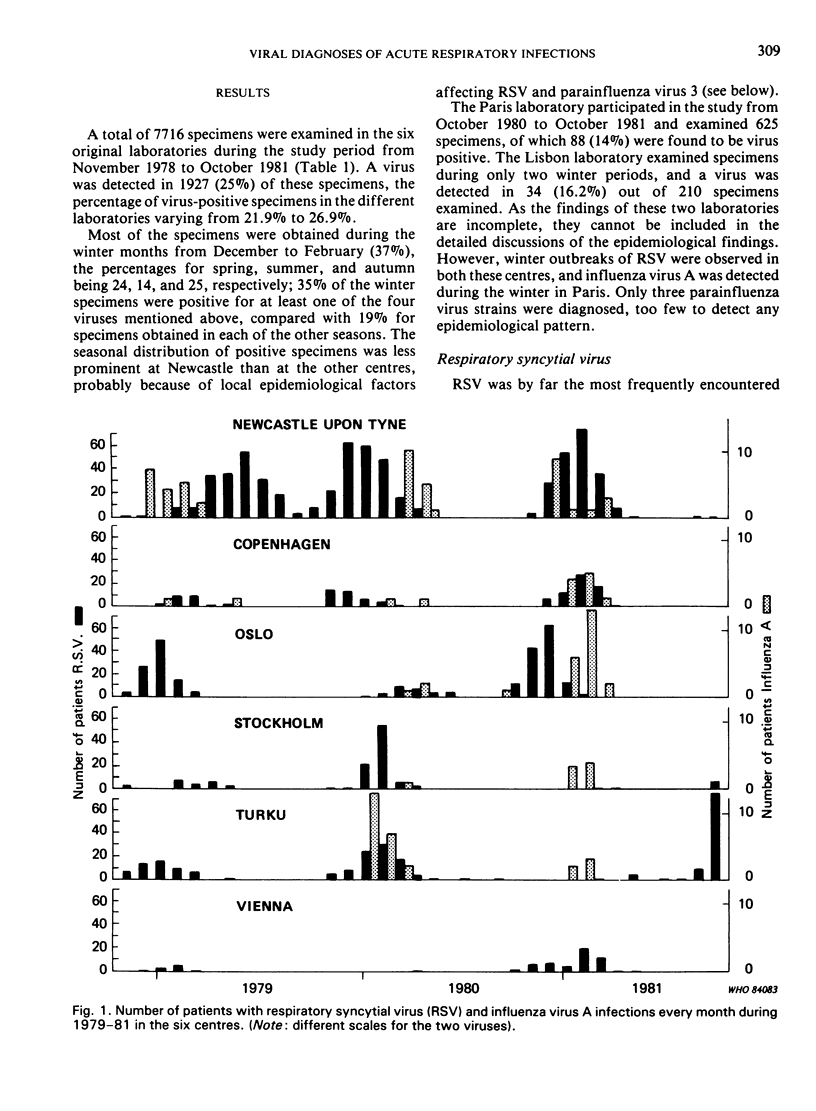
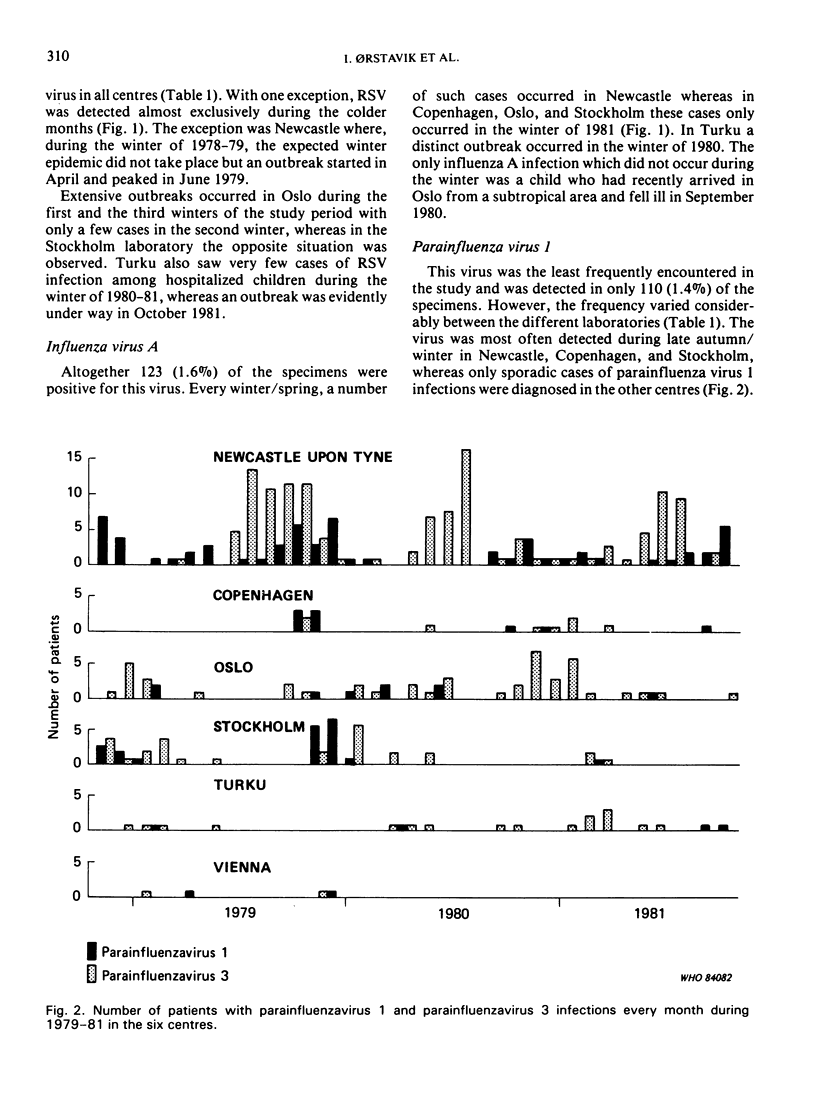
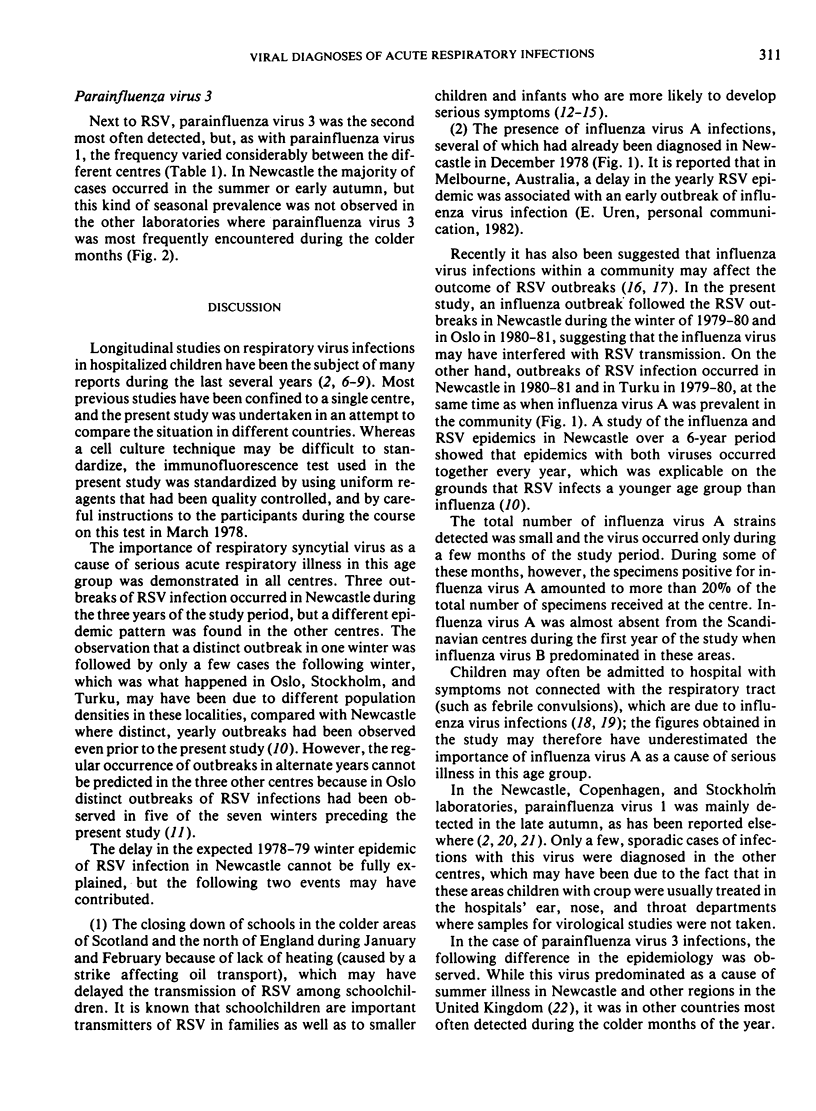

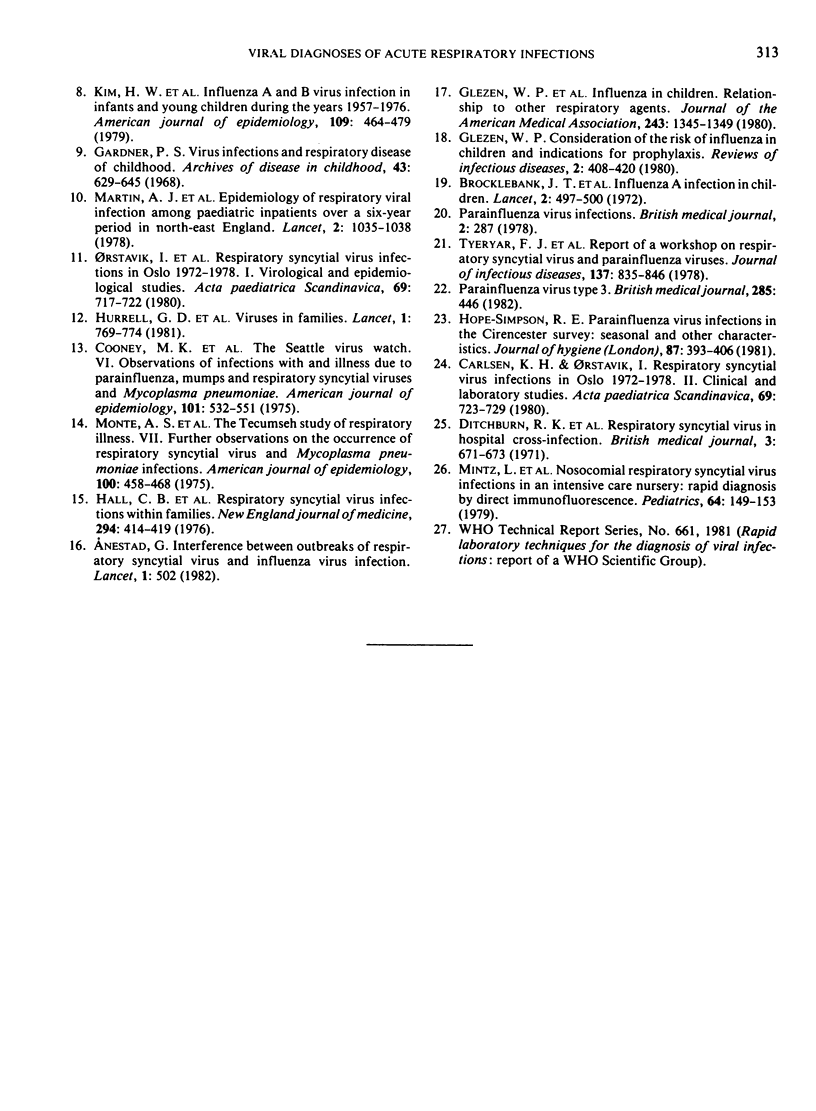
Selected References
These references are in PubMed. This may not be the complete list of references from this article.
- ANDREW J. D., GARDNER P. S. OCCURRENCE OF RESPIRATORY SYNCYTIAL VIRUS IN ACUTE RESPIRATORY DISEASES IN INFANCY. Br Med J. 1963 Dec 7;2(5370):1447–1448. doi: 10.1136/bmj.2.5370.1447. [DOI] [PMC free article] [PubMed] [Google Scholar]
- Anestad G. Interference between outbreaks of respiratory syncytial virus and influenza virus infection. Lancet. 1982 Feb 27;1(8270):502–502. doi: 10.1016/s0140-6736(82)91466-0. [DOI] [PubMed] [Google Scholar]
- Brocklebank J. T., Court S. D., McQuillin J., Gardner P. S. Influenza-A infection in children. Lancet. 1972 Sep 9;2(7776):497–500. doi: 10.1016/s0140-6736(72)91902-2. [DOI] [PubMed] [Google Scholar]
- Carlsen K. H., Orstavik I. Respiratory syncytial virus infections in Oslo 1972--1978. II. Clinical and laboratory studies. Acta Paediatr Scand. 1980 Nov;69(6):723–729. doi: 10.1111/j.1651-2227.1980.tb07140.x. [DOI] [PubMed] [Google Scholar]
- Cooney M. K., Fox J. P., Hall C. E. The Seattle Virus Watch. VI. Observations of infections with and illness due to parainfluenza, mumps and respiratory syncytial viruses and Mycoplasma pneumoniae. Am J Epidemiol. 1975 Jun;101(6):532–551. doi: 10.1093/oxfordjournals.aje.a112125. [DOI] [PubMed] [Google Scholar]
- Ditchburn R. K., McQuillin J., Gardner P. S., Court S. D. Respiratory syncytial virus in hospital cross-infection. Br Med J. 1971 Sep 18;3(5776):671–673. doi: 10.1136/bmj.3.5776.671. [DOI] [PMC free article] [PubMed] [Google Scholar]
- Gardner P. S. Virus infections and respiratory disease of childhood. Arch Dis Child. 1968 Dec;43(232):629–645. doi: 10.1136/adc.43.232.629. [DOI] [PMC free article] [PubMed] [Google Scholar]
- Glezen W. P. Considerations of the risk of influenza in children and indications for prophylaxis. Rev Infect Dis. 1980 May-Jun;2(3):408–420. doi: 10.1093/clinids/2.3.408. [DOI] [PubMed] [Google Scholar]
- Glezen W. P., Paredes A., Taber L. H. Influenza in children. Relationship to other respiratory agents. JAMA. 1980 Apr 4;243(13):1345–1349. doi: 10.1001/jama.243.13.1345. [DOI] [PubMed] [Google Scholar]
- Hope-Simpson R. E. Parainfluenza virus infections in the Cirencester Survey: seasonal and other characteristics. J Hyg (Lond) 1981 Dec;87(3):393–406. doi: 10.1017/s0022172400069631. [DOI] [PMC free article] [PubMed] [Google Scholar]
- Hurrell G. D., Sturdy P. M., Frood J. D., Gardner P. S. Viruses in families. Lancet. 1971 Apr 17;1(7703):769–774. doi: 10.1016/s0140-6736(71)91214-1. [DOI] [PubMed] [Google Scholar]
- Martin A. J., Gardner P. S., McQuillin J. Epidemiology of respiratory viral infection among paediatric inpatients over a six-year period in north-east England. Lancet. 1978 Nov 11;2(8098):1035–1038. doi: 10.1016/s0140-6736(78)92351-6. [DOI] [PubMed] [Google Scholar]
- Mintz L., Ballard R. A., Sniderman S. H., Roth R. S., Drew W. L. Nosocomial respiratory syncytial virus infections in an intensive care nursery: rapid diagnosis by direct immunofluorescence. Pediatrics. 1979 Aug;64(2):149–153. [PubMed] [Google Scholar]
- Orstavik I., Carlsen K. H., Halvorsen K. Respiratory syncytial virus infections in Oslo 1972--1978. I. Virological and epidemiological studies. Acta Paediatr Scand. 1980 Nov;69(6):717–722. doi: 10.1111/j.1651-2227.1980.tb07139.x. [DOI] [PubMed] [Google Scholar]
- Tyeryar F. J., Richardson L. S., Belshe R. B. From the National Institutes of Health: report of a workshop on respiratory syncytial virus and parainfluenza viruses. J Infect Dis. 1978 Jun;137(6):835–846. doi: 10.1093/infdis/137.6.835. [DOI] [PubMed] [Google Scholar]
- Wynne J., Hull D. Why are children admitted to hospital? Br Med J. 1977 Oct 29;2(6095):1140–1142. doi: 10.1136/bmj.2.6095.1140. [DOI] [PMC free article] [PubMed] [Google Scholar]


